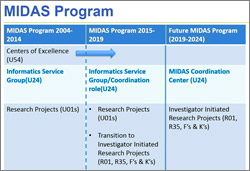UPDATE: The NIGMS reorganization became official in January 2018. Please see our Overview for more information.
I’d like to make you aware of a proposed reorganization of the Institute’s scientific divisions that we are considering.
Currently, NIGMS has four scientific divisions: Biomedical Technology, Bioinformatics, and Computational Biology (BBCB); Cell Biology and Biophysics (CBB); Genetics and Developmental Biology (GDB); and Pharmacology, Physiology, and Biological Chemistry (PPBC). We would like to shift to a structure in which there are only three scientific divisions: Biophysics, Biomedical Technology, and Computational Biosciences (BBCB); Genetics and Molecular, Cellular, and Developmental Biology (GMCDB); and Pharmacology, Physiology, and Biological Chemistry.
In broad strokes, the current CBB cell biology branch and most of the grants it manages would move to the new Genetics and Molecular, Cellular, and Developmental Biology division, and the CBB biophysics branch would move to the new Biophysics, Biomedical Technology, and Computational Biosciences division. A few grant portfolios from CBB would be transferred to the existing Division of Pharmacology, Physiology, and Biological Chemistry.
This proposed reorganization does not reflect any change in scientific emphasis or interests by the Institute. Rather, it is an attempt to improve the efficiency and effectiveness of our support for fundamental biomedical research, consistent with two goals outlined in our strategic plan [PDF, 702KB]: enhance the effectiveness of our support for fundamental biomedical research and improve the efficiency of our internal operations.
The proposed restructuring also includes establishing the Center for Research Capacity Building as a full division, consistent with its unique place in the Institute. In addition, based on a recommendation from the Steering Committee of the Office of Emergency Care Research (OECR), we plan to transfer the office to the National Institute of Neurological Disorders and Stroke (NINDS). Because of NINDS’ strong expertise in and support for clinical research related to emergency medicine, it is extremely well-suited to promoting the mission of OECR.
You might wonder what the proposed reorganization will mean for your current or future funding. Our commitment to funding fundamental biomedical research and research capacity building programs remains the same, so the amount of money allocated to these areas will not change as a result of the proposed reorganization. We also expect that most grantees will continue working with their current program directors and grants management specialists.
Soliciting input from the community is among the steps that need to occur before any changes can be implemented. We invite you to share your thoughts on these plans by commenting here or by email. Input will be received through December 4, 2017.




